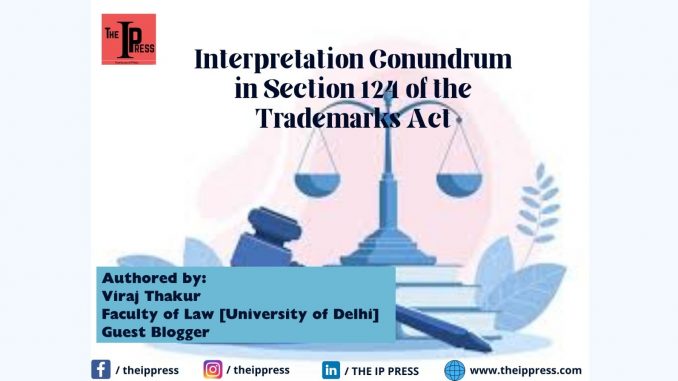

Introduction
Trade Marks Act, 1999 was enacted to replace an earlier Act named Trade and Merchandise Marks Act, 1999. Section 124 in the 1999 Act is a peculiar provision, which was also present with minor changes in the earlier 1958 Act under Section 111. The purpose of the section as outlined by head note is to stay the proceedings when registration of the trademark is itself is questioned. Though headnote mentions stay the suspension of proceeding is clearly bifurcated in “Stay” and “Adjournment” depending upon whether rectification is filed or not. Sub-Section (5) plays an important role in this conundrum, Sub-Section (5) enables the Court trying infringement suit to grant the injunction during the period of “Stay”. The plain reading of Section 124 can lead to the conclusion that interlocutory orders or injunction cannot be granted during the period of adjournment. The Hon’ble Delhi High Court has already highlighted inefficient legislative drafting of the Trade Marks Act, 1999 when examining another unrelated issue concerning Section 124 r/w Section 30.[1]The true position of Section 124 (5) can only be determined when Section is understood in detail by taking into account its architecture and purpose of the Sub Section (5).
Architecture of Section 124
It is apparent from perusal of Section 124 that this section is applicable in a suit of infringement when a claim regarding the validity of registration of the trademark is questioned. The two separate situations are contemplated by sub-section (1) of this section-
i. The rectification proceeding for the trademark in question has already been instituted
ii. No such proceeding has been instituted.
In the first situation the court is mandated to stay the suit pending final disposal of the rectification proceeding by virtue of Section 124 (1) (i). The second situation involves the discretion of the court. As per Clause (ii) of Section 124 (1) in a case where rectification proceeding is not initiated but the plea for invalidity of registration of trademark has been raised in the infringement suit court has to:-
i. Satisfy that plea for invalidity of registration of trademark has prima facie tenacity, and
ii. Raise an issue regarding the same, and
iii. Adjourn the case for three months to enable the party taking such a plea to apply to the High Court for rectification of the register.
Sub-Sections (2) and (3) are extensions of Clause (ii) of Sub-Section (1). Sub-Section (2) mandates that the party who has taken leave of the court to file rectification, must satisfy the Court within three months that application for such rectification has been made. Sub-Section (3) comes into play when the party who has taken leave of the court to file rectification and fails to file such rectification application within specified time. This Sub-Section mandates that on the failure of the party to file the rectification application the court shall proceed with the infringement suit and deem that the plea for invalidity has been abandoned by the party. Sub-Section (4) makes the decision taken in the rectification petition binding on parties and mandates the court trying the infringement suit to proceed with the suit in accordance with the decision regarding the validity of the registration of the trademark. Sub-Section (5) is an overriding provision over the previous Sub-Sections.
The architecture of the section makes it clear that the purpose of Section 124 is that, parallel proceedings to determine the validity of the Mark shall not be conducted and the appropriate forum shall determine the validity of the mark.[2]When Section 124 is read in its entirety a clear architecture appears. Section 124 (1) (i) requires a stay of suit as before the institution of suit the rectification petition is filed and the party is not cowering behind the question of invalidity to derail the suit. Section 124 (1) (ii) has been given an inbuilt safeguard as well as additional safeguards are given under Sub-Section (2) and Sub-Section (3). The distinction between Section 124 (1) (i) and Section 124 (1) (ii) is made to ensure that a plea of invalidity is not taken for the sake of defence.[3]Use of different modes to suspend proceedings is for the same purpose.
Use of words Suit and Case in Section 124 (1)
Interesting observation shall be made when reading languages of Clauses (i) and (ii) of Sub-Section (1). In clause (i) “Stay of suit” is mentioned whereas in Clause (ii) “Adjourn the Case” is mentioned. The beginning of Sub-Section is with words “Where in any suit for infringement”. This distinction clearly indicates that in Clause (i) as soon as a party to the suit brings a plea of invalidity and rectification proceedings are already initiated the suit of infringement is to be stayed. But if such proceedings are not initiated, the Clause (ii) will be attracted.
In the Code of Civil procedure, 1908 Section 115 concerning to the revision by the High Court an explanation regarding what is “any case which has been decided” appears. The explanation reads as, “Explanation. —In this section, the expression “any case which has been decided” includes any order made, or any order deciding an issue in the course of a suit or other proceeding.”[4] In absence of any explicitly defined scope of terms “Case” and “Suit”, it can be inferred from the CPC Section 115 that when a suit and case is used in the same section case is a part of the suit which has been arose during the proceedings of the Suit. “Case” is mentioned in Clause (ii) instead of “Suit”, the legislature did not intend to suspend the whole suit at the time of the framing of issues but it intended to suspend only the case/ part of that suit. The entire suit is suspended on compliance with the additional safeguard mentioned under Sub-Section (2).
In Clause (ii) only the case relating to the invalidity of the registration is adjourned for period of three months. It is a part of the suit, when the court makes the order to not allow the party to apply for rectification that case regarding invalidity of registration in the suit is terminated. If the court allows such leave and after three months if the party satisfies the court that rectification is duly applied court orders a stay of the entire suit and the case is terminated. If the party fails to apply for rectification court orders that party has deemed to abandon the plea of invalidity and the case regarding plea of invalidity is terminated but the suit of infringement continues. This clearly satisfies incidents of “Case” mentioned in Gupta & Co.[5], and hence plea of invalidity is a separate and distinct proceeding which when disposed of by an order made during the course is terminated but the suit remains continuing therefore, it can be argued that the Court is not barred from passing any interlocutory order in the Suit.
Purpose of Section 124 (5)
Section 124 (5) is meant as an overriding section. And its principle purpose is that wrongdoer shall not be allowed to continue committing the wrong only because he has taken a plea of invalidity.[6] It has been well recognized that Section 124 (5) is an enabling provision given under the Trademark Act to ensure that the court while suspending the proceeding for the time being shall not be robbed of power to give requisite interlocutory orders.[7] Such enabling provision shall not be read in a narrow sense, reading “stay” as only “stay” and inferring that court is barred from exercising its power granted in CPC Order XLI or as an inherent power under Section 151 of CPC would defeat the sole purpose of Section 124 (5).
Purposive Interpretation of Section 124 (5)
It is well-recognized principle that when literal interpretation brings an anomaly or defeats the purpose of any legislation “purposive interpretation” is the most appropriate interpretation tool.[8] The purpose of Section 124 (5) from the preamble of the Act and architecture of Section 124 is apparent. It is an enabling provision with an overriding effect on preceding Sub-Sections. It enables the court to exercise its power and jurisdiction to give such an interim/ interlocutory relief to the parties in the suit as necessary and to do the same Stay or Adjournment of the suit shall not become a bar.
Reading the Section in such manner won’t prejudice any party. Even if Section 124 (5) is read so as to be applied only after the court orders the stay of suit in Section 124 (2), the court needs to decide on interim relief applications 3 months from the order of adjournment. During these three months no material change will take place to get finality on the issue of validity of the registration for which the proceedings were suspended but party seeking the relief will continue to suffer the wrong. In today’s rapidly changing economy, the three months period can make or break businesses. Continued trademark infringement for three months might put a party out of business permanently rendering whole suit infructuous.
Conclusion
The conundrum in Section 124 of the Trade Marks Act, 1999 has two outcomes. Literally reading the Sub-Section (5) without considering the architecture of the Section may lead to an inference that interlocutory order within Section 124 (5) or under CPC can not be passed during 3 months of adjournment mentioned in Section 124 (1) (ii). But when architecture of the Act is taken into account and true purpose of Section 124 (5) is unearthed Section 124 (5) can be read as to enable the court to pass any interlocutory order as necessary.
[1]Intercontinental Great Brands LLC v Parle Product Private Limited, 2023:DHC:7974, Para. 12.
[2] Puma Stationer P. Ltd. and Another v Hindustan Pencils Ltd, (2010) 43 PTC 479, Para. 8 & 9.
[3] Burger King Corporation v Ranjan Gupta and Others, (2023) 94 PTC 137, Para. 11.
[4]The Code of Civil Procedure, 1908, Act 05 of 1908, Sec. 115.
[5] Gupta and Co. vs. Kripa Ram Brothers, AIR 1934 All 620, Para. 7.
[6] LT Foods Limited v Heritage Foods (India) Limited, (2018) 75 PTC 151, Para. 11.
[7] Clinique Laboratories LLC and Another v Gufic Limited and Another, (2009) 41 PTC 41, Para. 9 &14.
[8] Afcons Infrastructure Ltd. and Ors. vs. Cherian Varkey Construction Co. (P) Ltd. and Ors.; 2010 INSC 431, Para. 13.


Viraj Thakur
Author
Viraj Thakur is currently pursuing LLB from Law Center-1, Faculty of Law, University of Delhi. Viraj has graduated in B.E. (Electronics and Telecommunication) from RAIT, Nerul. Prior to joining law school, he has 3.5 years’ experience in intellectual property as Patent Analyst in one of the leading patent service provider companies. He is passionate about Intellectual Property law, Cyber law, Technology law and Law and policy in Emerging Technology. His research work demonstrates attention to detail, analytical rigour and innovative thinking. He is excited to start his legal career and make a positive impact.
- SEO Powered Content & PR Distribution. Get Amplified Today.
- PlatoData.Network Vertical Generative Ai. Empower Yourself. Access Here.
- PlatoAiStream. Web3 Intelligence. Knowledge Amplified. Access Here.
- PlatoESG. Carbon, CleanTech, Energy, Environment, Solar, Waste Management. Access Here.
- PlatoHealth. Biotech and Clinical Trials Intelligence. Access Here.
- Source: https://www.theippress.com/2024/06/05/interpretation-conundrum-in-section-124-of-the-trademarks-act/



